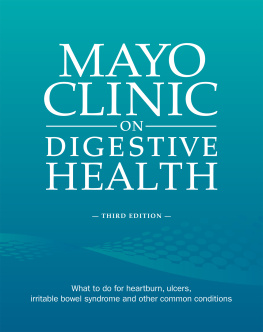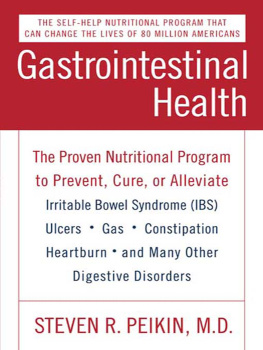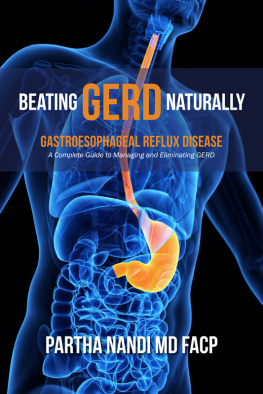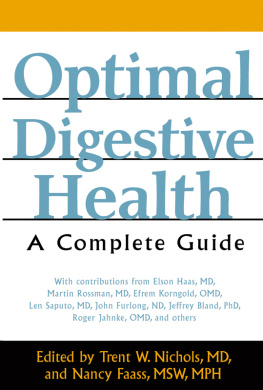Acknowledgments
First, I want to thank my wife, Michelle Sierpina, Ph.D., for her invaluable assistance in bringing birth to this book. She has been there since its early conception to help nurture and feed it through the nearly yearlong incubation period. She has been a midwife to chapter rewrites, resources, and improving my choice of words, metaphors, and humor. She also has set aside a good number of personal and family duties or taken on ones I should have been doing during this long birthing process. For all this, I thank her immensely.
I could not have achieved much of the richness and depth of the book without the wisdom of my colleagues and teachers at the Institute for Functional Medicine (IFM). David Jones, Patrick Hanaway, Jerry Mullin, Liz Lipski, Joe Lamb, and, of course, Jeff Bland are a few of the many from that excellent learning organization that I could name. Their continual research, clinical practice, and teaching have informed the new model of systems biology called functional medicine. Their willingness to generously share with me the developed resources, worksheets, and other materials from IFM programs and publications helps get functional medicine to the world.
Steve Pratt is a super Doc whose SuperFood approach to life has long energized me and my family, students, and patients. His hard work and research have helped shape many aspects of this book. Brittanya Washingtons cool, competent computer skills in assembling and formatting resources were critical to bringing the book to completion on time.
And finally I appreciate the professionalism and teamwork at New Harbinger in helping to bring this book to the public. Jess OBrien, Wendy Millstine, and Jess Beebe worked closely with my literary agent Barbara Deal and me through all stages of the books initial growth and development to bring it to you for your improved health. Thanks, too, to Brady Kahn for her patient, thoughtful editing and for dealing with my occasional conniption fits.
Thanks to you all.
 Victor S. Sierpina, MD, is professor of family and integrative medicine at the University of Texas Medical Branch in Galveston, TX, with over thirty years of experience in integrative medicine. His professional practice, courses, and research focus on natural health approaches to disease prevention and wellness.
Victor S. Sierpina, MD, is professor of family and integrative medicine at the University of Texas Medical Branch in Galveston, TX, with over thirty years of experience in integrative medicine. His professional practice, courses, and research focus on natural health approaches to disease prevention and wellness.
Foreword writer David Jones, MD, is president and director of medical education at the Institute for Functional Medicine in Gig Harbor, WA. He has practiced as a family physician with emphasis in functional and integrative medicine for over thirty years.
Preface writer Steven G. Pratt, MD, FACS, ABIHM, is a world-renowned authority on the role of nutrition and lifestyle in the prevention of disease and optimization of health. He is senior staff ophthalmologist at Scripps Memorial Hospital in La Jolla, CA, and author of several books, including SuperFoods Rx.
Chapter 1
Your Gut
An Owners Manual
As owner and operator of the food tube called the gut, wouldnt you like to have a better understanding of its component parts and how they work together? This chapter provides a description of gut processes and plumbing. It is a brief overview of digestive system anatomy and physiology for you, the informed consumer of food and beverages. While many medical texts cover this topic in depth, I will give you enough information, as briefly as possible, to make the rest of the book understandable and usable.
As you travel through the chapters ahead and do the various exercises, youll be well on your way to a healthy gut. In this spirit, I offer an ode of appreciation to the gut. It gives perspective to the overall value of nutrition and the gastrointestinal (GI) system to your life.
Ode to the Gut
Like the late comedian Rodney Dangerfield, the gut gets no respect. Its value in medicine and culture is far overshadowed by such organs as the heart, the eye, and the brain. Even Chinese medicine, which calls the heart the emperor of organs, gives a much stronger emphasis to the kidney than to the earthy elements in the gut.
A verse from the Good Book (1 Corinthians 1226) reminds us that each part of the body is vital and no part should be disrespected. Yet the gut, with its often embarrassing rumblings, outgassings, burps, belches, flatulence, vomitus, and olfactorily offensive offal is a bit like the slightly demented aunt, best kept quietly out of sight and out of discussion. This is an egregious error of epic proportions!
For example, consider the merits of the anus. First, remember the anus is the other end of a kiss. The sumptuous, sensuous lips are at the head of the river of intake to the gut. Lips are prominently featured in magazines, fashion photos, and the like. Alas, the poor anus remains hidden and uncelebrated. Yet get a pain in the a (nus), and note how quickly it is noticed in the brain. What other muscle in the body has such versatility and refined control? A true super muscle, it is able to contain and selectively eliminate gas, liquid, or solid matter! In these functions, it far exceeds the potential of the hand, our most developed tool-holding member.
Such a monstrous injustice! What body part was likely mentioned the last time you heard someone being spoken of disparagingly? This puts the excellent and essential anus in further disrepute. The anus sadly can draw little comfort from the fact that its urogenital neighbors also get lumped into such expletives and vituperatives. In any case, I call for nothing less than a revolution for gut appreciation.
In this brave new world of respect for the gut, the GI tract will be returned to its rightful place as the river of life. Like the Colorado, the Rio Grande, the Nile, or other great rivers, life without a gut is unimaginable.
We may abuse the gut with fast and fatty food, too much or too little food, toxins, and other misdemeanors and felonies, but remember that good health and good immunity begin with healthy nutrition and a healthy gut. Life itself is dependent on this lowly, gurgling, smelly organ system, without which the magnificent galaxy of other organs could not long endure.
So now pucker up as if preparing to give a kiss and project loving energy to your gut, from stem to stern, from the beginning of the kiss to its end.
Gross Anatomy: The Short Course
We start by taking a tour of the gut from start to finish. A general diagram of the GI tract is included for easy reference (see figure 1).

Figure 1: Diagram of the Digestive Tract
Oral Beginnings: Lips, Tongue, Mouth, Throat
The beginning of the GI tract anatomically is the lips, mouth, tongue, and pharynx (throat). Imagine biting into a bright-yellow sour lemon. Notice the pucker and saliva in your mouth. Now you realize that the functions of the mouth begin elsewhere in the brain, in the cephalic, or head phase, of digestion. Even thinking about and smelling the aromas from Mamas kitchen or a fine restaurant will start saliva and other digestive juices flowingbefore youve taken one bite. This process of digestion is beyond the mechanical acts of biting and chewing or the simple tastes of sweet, sour, salty, or spicy. It is a complex dance between thoughts, experiences, expectations, and the world of food and drink. Any good wine connoisseur knows that the nose and the subtle scents it can detect are as vital a part of the tasting experience as what happens in the mouth. This is protective to our health, since we can detect with high degrees of sensitivity when food is spoiled or offensive and therefore likely to make us sick. The salivary glands help to lubricate our food as we chew it and begin the digestive process. As you may recall from high school biology, saliva contains an enzyme called












 Victor S. Sierpina, MD, is professor of family and integrative medicine at the University of Texas Medical Branch in Galveston, TX, with over thirty years of experience in integrative medicine. His professional practice, courses, and research focus on natural health approaches to disease prevention and wellness.
Victor S. Sierpina, MD, is professor of family and integrative medicine at the University of Texas Medical Branch in Galveston, TX, with over thirty years of experience in integrative medicine. His professional practice, courses, and research focus on natural health approaches to disease prevention and wellness.